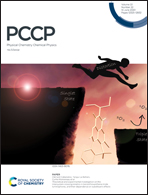VUV photoionization of the CH2NC radical: adiabatic ionization energy and cationic vibrational mode wavenumber determinations†
Abstract
The photoelectron spectroscopy of CH2NC (isocyanomethyl) radical species is investigated for the first time between 9.3 and 11.2 eV in the vicinity of the first photoionizing transition X+1A1 ← X 2B1. The experiment combines a microwave discharge flow-tube reactor to produce the radicals through the CH3NC + F → CH2NC + HF reaction, a VUV synchrotron radiation excitation, and a double imaging electron/ion coincidence spectrometer which allows the recording of mass-selected threshold photoelectron spectra. Assignment of the observed vibrational structure of the CH2NC+ cation is guided by ab initio calculations and Franck–Condon simulations. From the experimental spectrum, the first adiabatic ionization energy of the CH2NC radical is measured as 9.439(6) eV. Fundamental wavenumbers are determined for several vibrational modes of the cation: ![[small nu, Greek, tilde]](https://www.rsc.org/images/entities/i_char_e0e1.gif) 1+(CH2 symmetric stretch) = 2999(80) cm−1,
1+(CH2 symmetric stretch) = 2999(80) cm−1, ![[small nu, Greek, tilde]](https://www.rsc.org/images/entities/i_char_e0e1.gif) 2+(NC stretch) = 1925(40) cm−1,
2+(NC stretch) = 1925(40) cm−1, ![[small nu, Greek, tilde]](https://www.rsc.org/images/entities/i_char_e0e1.gif) 4+(H2C–N stretch) = 1193(40) cm−1,
4+(H2C–N stretch) = 1193(40) cm−1, ![[small nu, Greek, tilde]](https://www.rsc.org/images/entities/i_char_e0e1.gif) 6+(CNC out-of-plane bend) = 237(50) cm−1, and
6+(CNC out-of-plane bend) = 237(50) cm−1, and ![[small nu, Greek, tilde]](https://www.rsc.org/images/entities/i_char_e0e1.gif) 8+(CH2 rock) = 1185(60) cm−1.
8+(CH2 rock) = 1185(60) cm−1.



 Please wait while we load your content...
Please wait while we load your content...